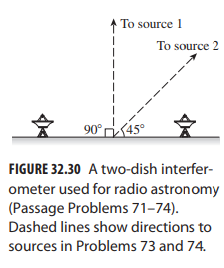Even the nearest stars are so distant that a single diffraction limited telescope capable of imaging Earth-size
Question:
Even the nearest stars are so distant that a single diffraction limited telescope capable of imaging Earth-size planets orbiting them would be hopelessly large (see Problem 45). Astronomers get around this limitation using interferometry to combine data from several telescopes, producing an instrument that acts like a single telescope with aperture equal to the distance between the individual telescopes (Fig. ?32.30). The technological challenge is to combine the signals with their relative phase intact; for this reason, interferometry has been used successfully for decades in radio astronomy but only recently with optical telescopes.
Data From Problem 45
NASA asks you to assess the feasibility of a single-mirror spacebased optical telescope that could resolve an Earth-size planet 5 light-years away. What do you conclude?
?
If the separation of two telescopes comprising an interferometer is doubled, the angular separation between two sources just barely resolvable by the interferometer willa. not change.b. decrease by a factor of 1/?2.c. halve.d. double.
Step by Step Answer:






